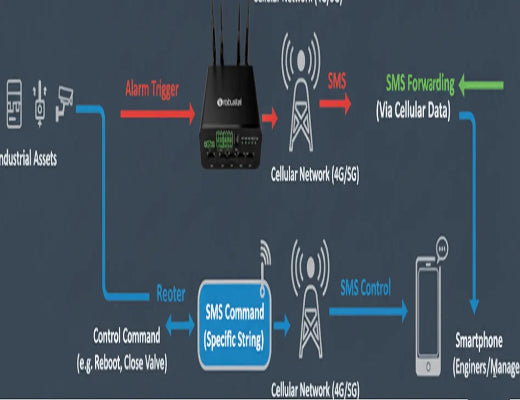
The SMS IoT Router: Your Ultimate Lifeline for Industrial IoT
|
|
Time to read 5 min
|
|
Time to read 5 min
An SMS IoT Router is an industrial-grade cellular router with the powerful ability to send and receive SMS text messages to monitor and control connected equipment.
It acts as a critical communication bridge, converting device alarms into SMS alerts and turning simple text messages into remote control commands.
his article explores why this technology is an essential lifeline for industrial automation, remote asset management, and critical infrastructure, especially when primary internet connectivity is unreliable.
Picture this: a critical water pump at a remote site goes down. The internet connection, which you rely on for monitoring, goes down with it. Panic, right? Not necessarily. What if you could send a simple text message to the industrial router connected to that pump and get a full diagnostic report, or even command a reboot? This isn't science fiction; it's the power of an SMS IoT Router.
In my years working with industrial deployments, I've learned that a "belt and suspenders" approach is always best. Your primary IP network is your belt, but what's your backup? For countless mission-critical applications, the universal, reliable, and low-bandwidth nature of SMS is the ultimate pair of suspenders. It's the communication channel that just works, even when everything else fails. So, isn't it time we looked at how this humble technology can be a total game-changer for your operations?
Let's be clear: we're not just talking about a cell phone chip in a box. An SMS IoT Router, often called an industrial SMS gateway, is a smart, ruggedized device built for the demands of the industrial world. It combines the features of a high-reliability cellular router with intelligent software for handling SMS traffic.
While the concept is powerful, the hardware is key. [cite_start]A device I've relied on for these exact scenarios is the Robustel R1520 Global, which is built for tough environments and provides extensive management options, including via SMS.
At its core, it performs three critical functions:
The real 'aha!' moment for many engineers is the concept of " Out-of-Band Management" ( OOBM). This means having a secure, alternative path to manage your infrastructure when your primary network (the "in-band" network) is down. An SMS IoT Router is the quintessential OOBM tool. Your fiber or Ethernet connection might be dead, but as long as the router has a flicker of a cellular signal, you have control. This capability turns a potential multi-hour disaster into a ten-minute fix.
The applications are practically limitless, but here are a few where I've seen this technology make a huge impact:
It's a fair question, but one that misunderstands the industrial challenge. You wouldn't use a family sedan for a heavy-duty construction job, would you? The same logic applies here.
Here’s what sets an industrial SMS IoT Router apart:
In short, a USB modem is a consumer gadget; an industrial router is a professional tool. For more insights into how to choose the right hardware, check out this guide on selecting industrial IoT devices. To learn more about the underlying communication principles, the concept of Machine-to-Machine (M2M) communication (opens in a new tab) is a great place to start.
A1: It’s a valid concern. Security is layered. First, an industrial SMS IoT Router like those from Robustel allows you to create a "whitelist" of authorized phone numbers. Only messages from these numbers will be accepted as commands. Second, the commands themselves are specific strings that an attacker would have to guess. While not as secure as a VPN, it's a significant barrier. For ultimate security, you should use SMS for alerts and out-of-band diagnostics, while using a secure VPN through a platform like RCMS for sensitive control operations.
A2: Nothing. The router's software is designed to parse incoming text messages and look for specific, predefined command strings. If a message doesn't match any known command, it is simply ignored. This prevents accidental commands or spam from affecting your operations.
A3: Yes, and this is a major advantage of a true industrial SMS gateway. Advanced routers can be configured to take the content of an incoming SMS and forward it to an HTTP API endpoint or publish it to an MQTT topic. This means your custom dashboard can receive and display field alerts that were transmitted via the SMS network, creating a truly unified monitoring system.


